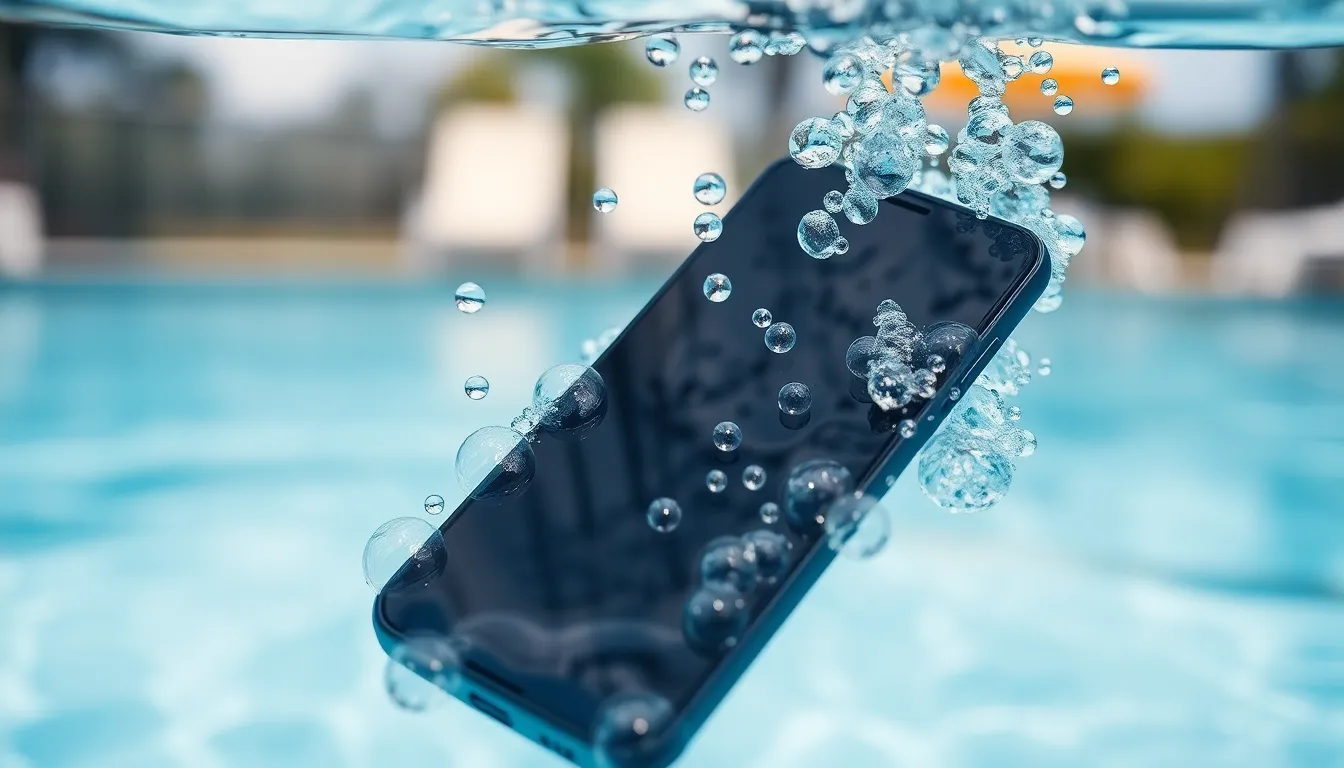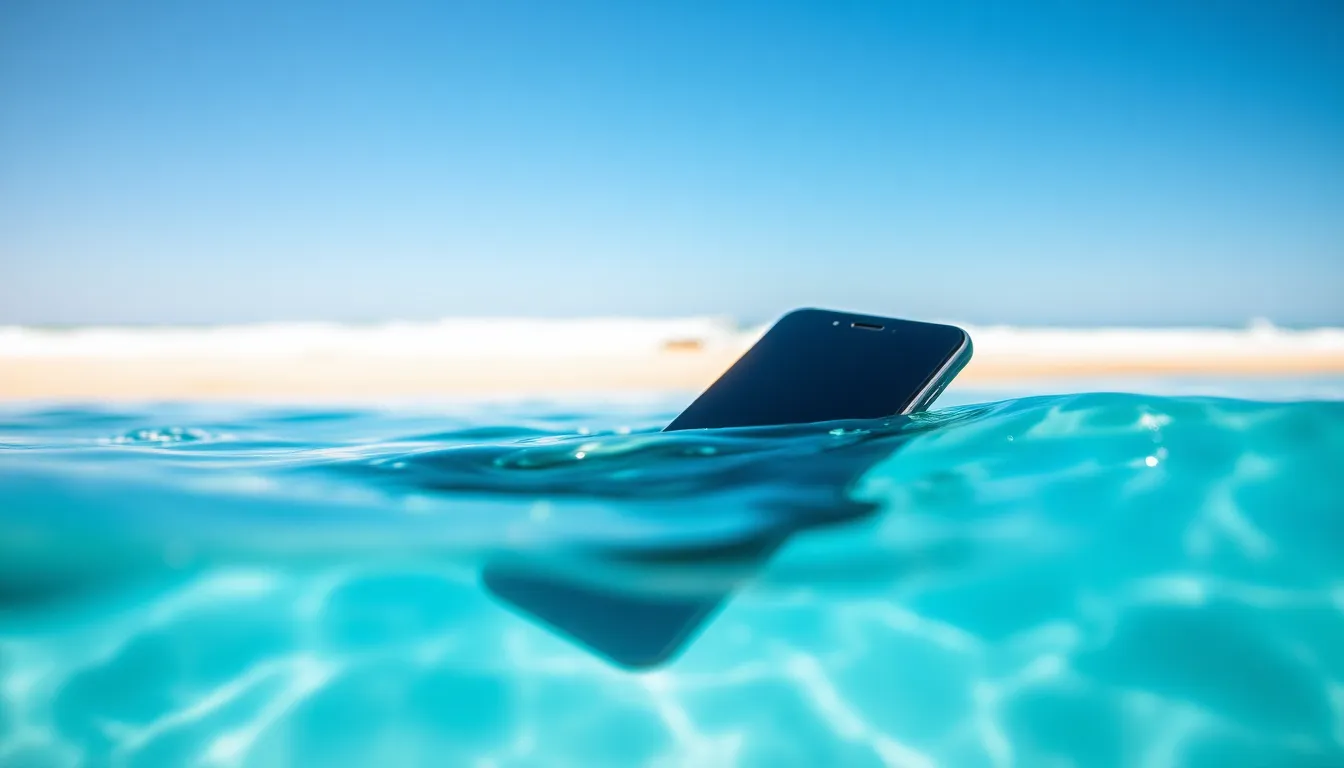In a world where a simple splash of water can spell disaster for your smartphone, knowing which phones can brave the elements is crucial. Imagine diving into a pool or getting caught in a downpour without a care in the world. That’s the beauty of waterproof phones—they’re like the superheroes of the tech world, ready to save your precious device from the clutches of moisture.
Table of Contents
ToggleThe Importance Of Waterproof Phones
Waterproof smartphones play a crucial role in today’s fast-paced environment. Users often encounter diverse scenarios, such as sudden downpours or accidental spills. Each instance can threaten a phone’s functionality and longevity.
Durability represents a significant advantage of waterproof devices, making them ideal for outdoor enthusiasts. Swim enthusiasts appreciate being able to capture underwater memories without concern. Those working in wet conditions find peace of mind knowing their devices resist moisture damage.
Ratings like IP68 or IPX7 indicate a phone’s waterproof capabilities, contributing to informed purchasing decisions. A device rated IP68 typically endures submersion in water beyond 1 meter for up to 30 minutes. Comparatively, an IPX7 rating allows for brief submersion, accommodating various activities and environments.
In addition, modern waterproof phones come with advanced technology to support photography. Users can enjoy high-quality images from the beach or poolside without worrying about water splashes. Features like dust resistance accompany waterproof ratings, promoting overall device longevity.
Enhanced connectivity remains another essential feature of waterproof smartphones. Users continue enjoying full functionality, even in challenging weather conditions. With the rise of mobile communication, having a reliable device becomes increasingly critical.
Investing in a waterproof phone establishes a safeguard against potential accidents and enhances everyday convenience. This investment offers users confidence in their devices, empowering them to explore without limits.
Common Waterproof Ratings

Smartphones today vary in their waterproof capabilities. Ratings help users understand how their devices will perform in water exposure situations.
IP Ratings Explained
IP ratings consist of two digits, where the first indicates protection against solids and the second against liquids. For instance, an IP68 rating signifies a phone’s resilience to dust and immersion in water up to 1.5 meters for 30 minutes. Conversely, an IPX7 rating suggests resistance to water but not dust, allowing for brief immersion in up to 1 meter of water. These ratings provide clarity on a device’s durability, making them essential for buyers.
Understanding Waterproof Standards
Standards for waterproofing focus on real-world scenarios users encounter. An IP67 rating denotes protection against submersion in water for up to 30 minutes at depths of 1 meter. Meanwhile, higher ratings like IP68 exceed these expectations, accommodating deeper depths and longer durations. Every standard reflects rigorous testing, ensuring devices can withstand specific conditions. Manufacturers adhere to these benchmarks, offering clearer insights into waterproof features for consumers.
Top Waterproof Phones In 2023
Several smartphones stand out in 2023 for their waterproof capabilities, making them excellent choices for users who value durability and performance.
Premium Options
The iPhone 14 Pro boasts an IP68 rating, ensuring durability against water at depths of up to 6 meters for 30 minutes. Samsung Galaxy S23 Ultra, another premium pick, features IP68 protection, allowing immersion up to 1.5 meters for the same duration. Google Pixel 7 Pro also meets IP68 standards, providing reliable performance in wet conditions. Sony Xperia 1 IV, known for its robust waterproofing, can handle submersion up to 1.5 meters. These devices not only offer protection but also maintain high-quality performance, solidifying their status as top-tier waterproof phones.
Budget-Friendly Choices
Several options provide waterproof features without breaking the bank. The Samsung Galaxy A54 includes an IP67 rating, offering protection against dust and water immersion for up to 30 minutes at 1 meter. Motorola Moto G Power (2023) also achieves IP67 compliance, ensuring reliability for everyday use around moisture. Another budget-friendly choice, Nokia G50, meets IP68 standards, providing excellent protection at a lower price point. These phones prove that affordability and durability can coexist, making them practical selections for consumers seeking waterproof devices.
Factors To Consider When Choosing A Waterproof Phone
Choosing a waterproof phone involves several key factors. Awareness of these can ensure a suitable selection.
Durability and Build Quality
Durability plays a vital role in waterproof phones. Look for devices that feature materials like Gorilla Glass or aluminum, which enhance resilience against drops and scratches. Phones with reinforced frames often endure rough use better. Build quality matters, as higher-grade materials generally contribute to longer-lasting performance. It’s essential to select a model that meets or exceeds IP67 or IP68 ratings, indicating tested protection against water and dust. Premium brands tend to offer devices known for their solid construction, giving users confidence in outdoor settings.
Additional Features
Additional features distinguish waterproof phones from regular devices. Superior camera technology supports high-quality imaging in wet environments, making spontaneous moments capture possible even during rain. Enhanced connectivity options ensure reliable performance, whether texting during downpours or utilizing streaming services in humid conditions. Some models include water-resistant capabilities for specific functions, like touchscreens that remain operational when wet. Battery life can also be a consideration, as certain designs improve longevity under moisture exposure, adding extra assurance during outdoor adventures. Look for these features to maximize functionality and reliability.
Real-World Performance Tests
Waterproof phones undergo various practical assessments to ensure reliability in wet scenarios. Testing protocols often simulate real-life conditions, evaluating how devices perform when submerged in water.
Water Resistance Testing
Manufacturers typically implement rigorous water resistance tests, adhering to standards like IP67 and IP68. These tests involve submerging devices in water up to 1.5 meters for 30 minutes, confirming their durability under pressure. Notable models such as the iPhone 14 Pro and Samsung Galaxy S23 Ultra consistently pass these evaluations without issues, showcasing their strong performance. User expectations also drive these tests, emphasizing practicality in everyday situations like accidental spills or rain exposure.
User Experiences and Reviews
User feedback provides critical insights into the real-world effectiveness of waterproof phones. Reviews often highlight specific scenarios where devices excel, like taking pictures during a downpour or using phones at the beach. Many users report satisfaction with models like the Google Pixel 7 Pro, appreciating its functionality and camera quality even in challenging conditions. While experiences vary, overall satisfaction tends to correlate with the device’s waterproof rating and build quality, reinforcing the importance of informed choices when selecting a waterproof phone.
Waterproof smartphones have become essential for those who lead active lifestyles or simply want peace of mind in unpredictable weather. With various models available across different price ranges users can find a device that meets their needs without sacrificing durability.
Understanding IP ratings is crucial for making informed decisions and ensuring that the chosen phone can withstand moisture exposure. Whether it’s capturing memories at the beach or navigating a sudden downpour these devices provide reliability and functionality.
Investing in a waterproof phone not only protects valuable technology but also enhances the overall user experience by allowing for seamless use in diverse environments. As technology continues to advance waterproof features will likely become standard in many smartphones making them a smart choice for every user.




